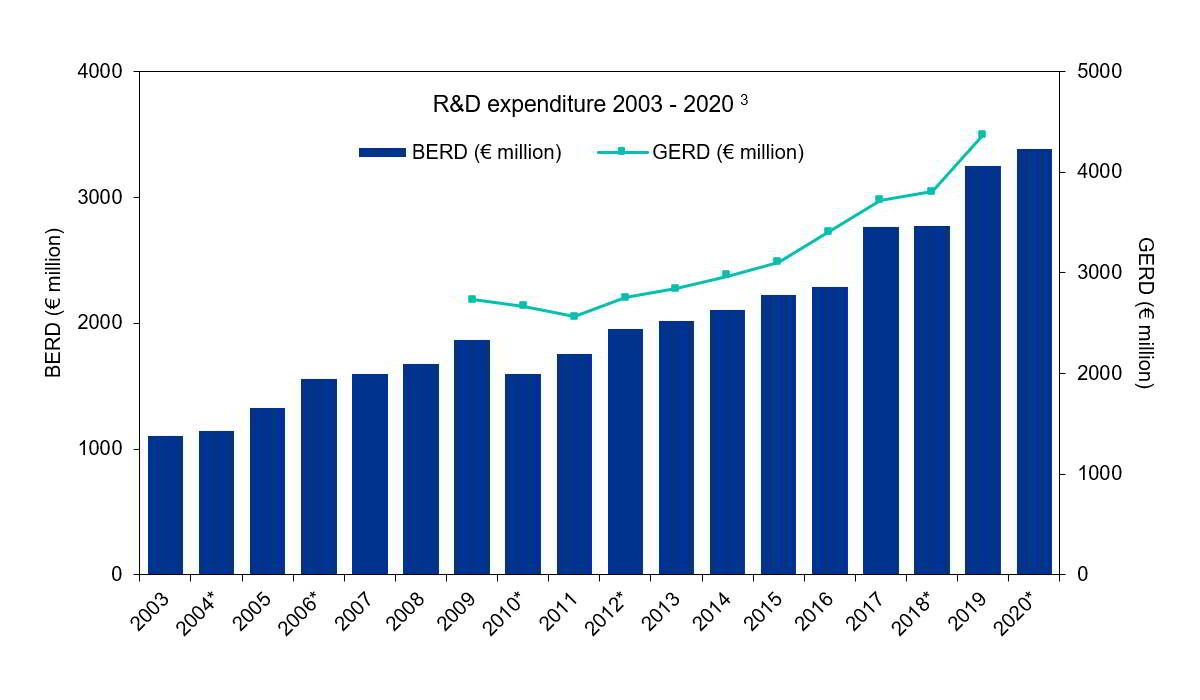Ireland’s RD&I landscape is one characterised by resilience and innovation. As the country feels the brunt of global economic headwinds, how will the Research, Development & Innovation (RD&I) sector fare, asks Eoin McCarthy, PhD.
“Uncertainty breeds innovation” – a fitting term to describe Irelands RD&I landscape over the past three years. Our agility, resilience, creativity, and innovation in the face of adversity has reset the baseline for what’s achievable in relatively short time frames – digital integration and the increased cadence of complex vaccine production are great examples. As we face renewed economic headwinds, it’s time to take stock and consider how economic uncertainty impacts the innovation lifecycle.
Investing in RD&I during a downturn
Investing in RD&I is a core strategy to maintain market competitiveness and prosper growth. It is an important pillar in a business model that underpins medium-long term sustainability. During challenging times as economic crisis unfolds, the instinct may lean toward short-term conservation to minimise risky expenditure and maintain the status quo of the core business. Indeed, we have observed unexpected external levers erode the bottom line: energy price volatility and aggressive inflation precipitously increasing operation costs.
Although an important strategic pillar, RD&I is inherently risky and typically requires significant financial investment, in which the return may only be released several years later, if ever. When increased economic uncertainty begins to influence corporate strategy, RD&I expenditure may be scrutinised with the aim to control costs.
However, if we analyse RD&I spending during previous economic downturns, there is evidence to show that companies that maintain or increase RD&I activity outperform others when market conditions improve[1]. Analysis from the financial crisis in 2009 showed that organisations that maintained their innovation focus emerged in a stronger position, outperforming the market average by circa 30% and continued to deliver accelerated growth over the subsequent three to five years[2]. Although the fact pattern is a little different to current economic challenges, the underlying effect gives rise to some optimism.
“…companies that maintain or increase RD&I activity outperform others when market conditions improve.

How Ireland fares
Looking closer to home, Ireland is an important and established hub for Industrial R&D. We have observed an increase in large scale investment from both the indigenous and FDI sectors. Although elements of the Tech sector are reducing headcount to a greater or lesser extent, the Life Sciences and manufacturing sectors are expanding with several major development projects recently announced. This is very positive for Ireland across the short, medium and long term. However, Ireland is very much a globally integrated economy, and the global outlook remains unclear. We are a little exposed, especially given our reliance on FDI.
How did RD&I perform during the last economic downturn?
Analysing Ireland’s business expenditure on R&D (BERD) over time provides a good insight into how our innovation landscape reacted to economic challenge in the past. The plot below shows the quantum of BERD between 2003 – 2020, spanning the 2009 financial crisis. Although there is a slight erosion of BERD in 2010, the magnitude is very small relative to the widespread economic destruction that happened at the time. Furthermore, Ireland’s BERD rapidly recovered, and grew significantly up to 2020, the most recent data set[3].
It is interesting to note that gross expenditure on R&D (GERD) across the same period trends with BERD. Even as the government budget allocated to R&D declined and plateaued between 2009 – 2017, business investment in R&D increased. In mapping this performance to our current environment, we are well positioned to maintain, and perhaps grow, our RD&I landscape through this bout of economic uncertainty.

Ireland’s strategy
Our national enterprise policy formulates a crosscutting strategy to drive RD&I, captured in a white paper recently published by the Department of Enterprise, Trade and Employment which outlines Ireland’s enterprise policy over the medium term, to 2030[4]. The policy identifies several strategic objectives for Irish-based enterprise to succeed from an innovation, sustainability, and productivity perspective, and defines several important target metrics, all ambitious and mostly achievable. A key aim is doubling BERD by 2030, which is realistic if we incentivise RD&I appropriately.
Focussed supports across our industry base will drive BERD over the long term, with important spin off and additionality effects: retention of highly skilled labour force and improved innovation infrastructure for example. Indeed, novel RD&I grant initiatives, such as the Disruptive Technologies Innovation Fund, have added to our innovation toolkit4. Broadening the type and scope of RD&I grants and tax-based incentives will be crucial in keeping pace with other small, advanced economies who pose a risk to the competitiveness of our economy.
Outlook
As the crisis unfolds, Irish based businesses will be exposed to increased financial pressure which is likely to stick with us into the near future. Leveraging government support to subsidise R&D will become increasingly important. Indeed, supporting industry is the cornerstone to our national RD&I policy. Ireland’s research and innovation strategy highlights the important support structures ensuring we remain competitive in an uncertain European and Global economy[5]. An important lever to success lies in growing collaboration between academia and Industry, as well as incentivising industry driven R&D through the IDA, Enterprise Ireland, and the R&D tax credit.
Targeted incentives deliver an important multiplier effect, greater than the sum of its parts. Recent changes to Ireland’s R&D tax credit scheme have ensured that it remains an attractive incentive for taxpayers after the introduction of the OECD's minimum tax rate proposals under Pillar Two, and changes to the US foreign tax credit regulations. Especially important as many US headquartered multinationals have significant operations in Ireland.
Fostering our RD&I ecosystem by improving national, European and global connectivity is as important now than ever, and allows us to remain at the “coal face” of R&D. We have shown great success embedding ourselves in Europe. It is critical that this remains central in policy. Thankfully, increasing our participation and impact in “Horizon Europe” has been identified as key target in Impact 2030[6].
Investment in RD&I during an economic downturn has real tangible and intangible benefits. Developing new technologies, products and processes will enhance a company’s competitiveness and growth during the recovery phase. Engaging RD&I programs will help retain and develop key subject matter expertise within an organisation.
Ireland’s industry sectors have shown great resilience and agility, and will no doubt have both short and long-term success in the face of economic headwinds.
Footnotes
- Ellis Terry, Brian Dearnley “Driving research & development in a downturn, 16 April 2020”
- McKinsey, “Innovation in a crisis: Why it is more critical than ever, 17 June 2020”
- BERD and GERD data sourced from Irelands Central Statistics Office (CSO)
- “White Paper on Enterprise”, Department of Enterprise, Trade and Employment.
- “Impact 2030: Ireland’s Research and Innovation Strategy”, Department of Further and Higher Education, Research, Innovation and Science
- “Impact 2030: Ireland’s Research and Innovation Strategy”, Department of Further and Higher Education, Research, Innovation and Science
Get in touch
In KPMG’s R&D Incentives Practice, we have significant experience in identifying the right approach across the varied funding mechanisms and can add value to your RD&I. Contact our team today if we can assist you and your business.
Eoin McCarthy
Associate Director
KPMG in Ireland

